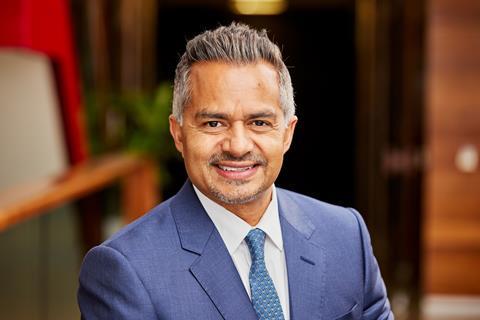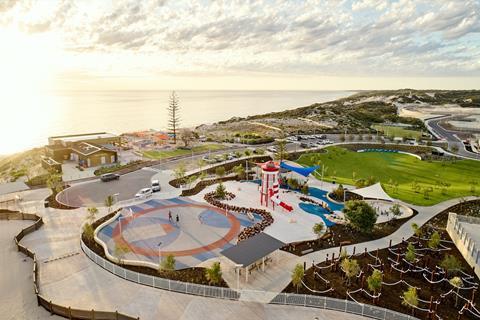
Barely three months through the front door, Tarun Gupta is set to refurbish the 70-year-old ‘house’ built by Hungarian migrant Ervin Graf in 1952. The house is Stockland, which over seven decades has morphed into one of Australia’s largest diversified property groups, with a market capitalisation of A$11bn (€6.8bn) and ranking among the top-five real estate investment trusts (REITs) listed on the Australian Securities Exchange.
Gupta, former chief financial officer of Lendlease, was headhunted last year to become Stockland’s managing director and CEO. He hit the road running in June, putting in train a strategic review to map out the direction the business should take in the coming years.
One of the first major transactions under his leadership was the purchase of Halcyon Retirement Communities for A$620m. Stockland has also been named among shortlist of bidders for AMP Capital’s A$7bn Capital Wholesale Office Fund, although would not comment on the subject.
In the Stockland camp today are several former executives of AMP Capital, including Adam Tindall, formerly its CEO, Louise Mason, former chief operating officer for real estate, and Peta Carruthers, former deputy fund manager of AMP Capital. Having been one of the less high-profile A-REITs in the past, Stockland today is generating market buzz in anticipation of its next moves.
The past decade has witnessed many of its contemporaries – including those with smaller capitalisation, push into third-party fund management to expand their businesses. Stockland did not follow the herd and, unusually, it holds all but 3% of its assets on its balance sheet.
The upshot is a group rich in assets worth A$11.5bn and a A$33bn development pipeline, both of which are ripe for picking. Stockland is well positioned to attract the attention of global and domestic institutional investors scrambling the world over for stable, income-producing real estate assets.
Stockland’s ability to grow self-sufficiently and without third-party capital is derived principally from annual residential sales that churn out cash flows and support a business that has low levels of financial gearing (21% in 2020).
“Our operating cash flow from residential sales has been strong for a long time,” says Gupta. “We also have good income returns from our investment portfolios, which have been yielding more than 6% in earnings per share.”
In some ways, COVID-19 has played into the hands of Stockland, enhancing the real estate it operates: housing, logistics, life-sciences and convenience retail
“I see Stockland playing to its strengths,” says Gupta. “The enduring strength of Stockland has been as an asset creator.”

Stockland has a 60m sqm landbank, which Gupta says is equivalent to 20 Sydney cental business districts (CBDs) and will allow the group to leverage its scale and market reach to create additional revenue streams and recurring earnings.
Just over a year ago Stockland formed its first capital partnership, bringing in Thai developer Supalai to jointly develop a master-planned community in Melbourne. Supalai’s investment was a modest A$52.5m. In December last year, Stockland formed a A$1bn logistics partnership with JP Morgan Asset Management.
Gupta says Stockland is “at the start of the journey” third-party fund management. With 20 years of building capital partnerships, he will be in a good position to lead the way. He has already begun preliminary conversations with a range of global investors and Australian superannuation funds.
“We see globally that pension funds continue to lift their allocations to real estate assets. In Australia, the super contribution is increasing from 9.5% to 12% by 2025,” he says. “This should underpin increasing domestic demand for quality income-producing real estate with returns from existing core assets having tightened materially over the last several years.”
Gupta says rapid technological development has increased the risk of obsolescence for all real estate sectors, and Stockland’s “end-to-end capability” to build core assets will play a useful role. “We have a key point of differentiation,” he says.
“We are an asset creator, which is very attractive to pension funds and capital partners, because they get access to quality products on an efficient basis and share some of the risks to get enhanced returns. We have core capabilities. We are involved from start to finish right through the value chain in the creation of our assets.”
Although the strategic review is not due to be available until the end of this year, Gupta has a good idea of how and from where future growth will arise, and is allocating capital accordingly.
In simple terms, Stockland will focus on the global thematic of “beds and sheds”, he says. “These thematics are very much alive. They were alive before COVID, they have accelerated during COVID, and they are likely to continue into the future.”
He adds: “The role of distribution warehouses has benefitted from the rotation into e-commerce – and that is continuing to accelerate, both in Australia and globally.”
Stockland ranks as the fourth-largest developer and manager of logistics assets in Australia. Over the past five years, its logistics portfolio has grown by 60% to 35 assets worth A$3.7bn and accounts for 25% of total assets under management. Stockland’s development programme is intended to produce a further A$3.3bn worth of assets in the coming years.
As for residential, Stockland is “the number one creator of homes in Australia”, according to Gupta. “Our master-planned, greenfield-communities business is three times bigger than our nearest competitor.”
Gupta believes Stockland can use its skills to increase its reach into other areas of housing. One is “land lease”, the provision of manufactured housing for those looking to downsize, which Stockland entered through its acquisition of Halcyon Retirement Communities. “Our ambition is to be a leading player in the emerging sector,” says Gupta.
Stockland already had a retirement business, but Halcyon will be operated as a standalone platform. While the average age of individuals living in Australian retirement villages is 80, customers of manufactured home estates tend to be “early retirees in their 50s”, Gupta says. “This segment of the Australian population is growing at 2.5% a year and it does not rely on immigration.”
As Stockland expands into the land lease sector, it will seek to introduce capital partners into the business, Gupta says. The group is also planning to “upweight” and broaden its exposure to residential, including the build-to-rent (BTR), which is an emerging sector in Australia compared with some European and North American markets.
“The land-lease business gives us single-family BTR [build-to-rent], and, over time, we will explore multi-storey apartments as part of our strategy to develop more income-producing residential assets,” says Gupta. “Australia does have some structural problems – tax and other issues – [but] with two strong thematics – consumer preference and affordability – driving it, the sector has promising potential.”
In its bread-and-butter business, the sale of detached housing in master-planned estates, Stockland sales have strengthened in the wake of a COVID-19 housing boom in Australia. Net deposits rose 54% in the 12 months to June 30 over the prior year.
“As we emerge from the pandemic, the long-term trend of urbanisation and urban renewal of big cities will continue,” says Gupta. “Since COVID, we have observed that almost 20% of inner urban buyers have turned to suburbs to seek larger homes and enhanced community wellbeing.”
Until recently, Stockland has not focused on CBD office, but that is about to change. On the drawing board are two large “workplace” projects in Sydney, which could one day be worth more than A$3bn. “We are planning to develop the workplace of the future on these sites,” says Gupta.
“New-age buildings which house the latest technologies and provide the best health and wellbeing outcomes will be the assets that perform best in future. Clearly, there is a change taking place. And there is also a big desire from both employees and employers to return to the office, because you just can’t work from home every day.
Gupta also highlights the potential of recycling capital from Stockland’s retail and retirement portfolios. The company has A$1.2bn tied up in 59 established retirement villages and a further A$5.5bn in 26 town-centre retail assets, representing about 60% of its balance sheet. “We would like to reduce the heavy weighting to those sectors,” Gupta says.
Its sale of a shopping centre in Bundaberg, Queensland, for A$140m in August helped. But it is worth noting that, unlike prime shopping malls, Stockland’s town-centre retail assets cater to non-discretionary spending and are supported by the recent rise in shopping locally. Last financial year, 75% of sales at Stockland centres were in non-discretionary spend. The centres have surplus land, which can be repositioned for alternative use, Gupta says.
It might be somewhat late in going down the capital partnership route, but Stockland is opening up a full book of opportunities in logistics, land lease and residential.


















